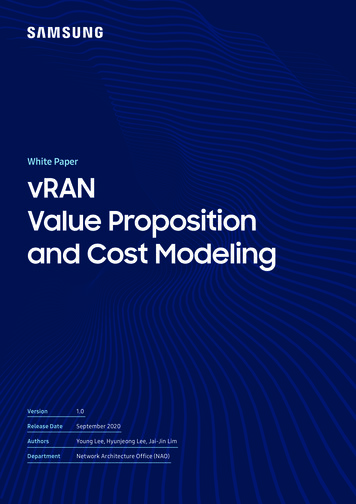
Transcription
AN INTELINTEL COMPANYCOMPANYANvRAN: The Next Step in NetworkTransformationBoost Capacity, Reduce Cost, and Enhance Customer Experience withWind River, Altiostar, Amdocs, and Dell EMCWHEN IT MATTERS, IT RUNS ON WIND RIVER
VRAN: THE NEXT STEP IN NETWORK TRANSFORMATIONEXECUTIVE SUMMARYVirtualized radio access network (vRAN) is the next step in the evolution of mobile networks,promising to intelligently boost capacity, dramatically reduce costs, and enhance customerexperience. It will also provide the flexibility and dynamic scalability that will be necessaryto support future services and applications. The vRAN architecture goes beyond the latestiterations of centralized RAN (C-RAN) by running virtualized baseband functions on commodity server hardware, based on the principles of Network Functions Virtualization (NFV).As communications service providers (CSPs) are under pressure to keep up with capacitydemands and launch differentiated offerings in a highly competitive mobile services market, thetime is right to extend the benefits of NFV from the core network to the RAN.Altiostar, Amdocs, Dell EMC, and Wind River offer a complete, pre-integrated vRAN solutionthat cost-effectively delivers carrier grade performance, massive scalability, and rapid serviceinstantiation for 4G networks today while laying the foundation for 5G networks in the future.The vRAN solution comprises the following key components: Altiostar vRAN solution is a pioneering software-intensive LTE eNodeB with Ethernet fronthaul that improves performance, reduces costs, and simplifies infrastructure expansion whileimproving the customer experience. Amdocs Network Cloud Service Orchestrator (NCSO) is an open, catalog-driven solution thatcontinuously designs, fulfills, and assures network services from any virtual network functionover all mainstream cloud management systems and SDN controllers. Amdocs also providesprofessional services for designing, deploying, operating, and optimizing mobile networks. Dell EMC PowerEdge R630, an ultra-dense, two-socket 1U rack server, is versatile and highlyconfigurable for a variety of solutions, delivering the latest Intel Xeon processor E5-2600v4 product family, 24 DIMMs of high-performance DDR4 memory, and a broad range of localstorage options. Wind River Titanium Cloud is the industry’s only fully integrated, ultra-reliable, and deployment-ready family of virtualization platforms that enable service providers to deploy virtualized services faster, at lower cost, and with guaranteed uptime.This solution brief details the business and technical benefits of the combined vRAN solution,which will enable CSPs to cost-effectively scale capacity to meet rising traffic demands on 4G LTEnetworks today and gain the flexibility, agility, and scalability needed for 5G networks in the future.TABLE OF CONTENTSExecutive Summary. . . . . . . . . . . . . . . . . . . . . . . . . . . . . . . . . . . . . . . . . . . . . . . . . . . . . . . . . . . . . . . 2Introduction. . . . . . . . . . . . . . . . . . . . . . . . . . . . . . . . . . . . . . . . . . . . . . . . . . . . . . . . . . . . . . . . . . . . . 3Complete vRAN Solution. . . . . . . . . . . . . . . . . . . . . . . . . . . . . . . . . . . . . . . . . . . . . . . . . . . . . . . . . . 4Carrier Grade Reliability . . . . . . . . . . . . . . . . . . . . . . . . . . . . . . . . . . . . . . . . . . . . . . . . . . . . . . . . . . . 5Ultra-Low Latency . . . . . . . . . . . . . . . . . . . . . . . . . . . . . . . . . . . . . . . . . . . . . . . . . . . . . . . . . . . . . . . . 5Best-in-Class Manageability and Orchestration. . . . . . . . . . . . . . . . . . . . . . . . . . . . . . . . . . . . . . . . 6Maximum Resource Utilization and Performance. . . . . . . . . . . . . . . . . . . . . . . . . . . . . . . . . . . . . . . 7Flexible Deployment Options . . . . . . . . . . . . . . . . . . . . . . . . . . . . . . . . . . . . . . . . . . . . . . . . . . . . . . 7Open Standards and Open APIs. . . . . . . . . . . . . . . . . . . . . . . . . . . . . . . . . . . . . . . . . . . . . . . . . . . . 7Pre-integrated Solution Versus Build Your Own. . . . . . . . . . . . . . . . . . . . . . . . . . . . . . . . . . . . . . . . 8Complete vRAN Solution Delivers Business Benefits. . . . . . . . . . . . . . . . . . . . . . . . . . . . . . . . . . . . 8Summary . . . . . . . . . . . . . . . . . . . . . . . . . . . . . . . . . . . . . . . . . . . . . . . . . . . . . . . . . . . . . . . . . . . . . . . 9Appendix 1: Titanium Cloud Ecosystem for vRAN. . . . . . . . . . . . . . . . . . . . . . . . . . . . . . . . . . . . . . 9Appendix 2: Titanium Cloud Features. . . . . . . . . . . . . . . . . . . . . . . . . . . . . . . . . . . . . . . . . . . . . . . 10 2 White PaperAN INTEL COMPANY
VRAN: THE NEXT STEP IN NETWORK TRANSFORMATIONINTRODUCTIONlocated at the base of the cell tower or in a nearby cabinet, and theThe volume and variety of mobile traffic continues to grow atRRU is connected to the antennas at the top of the tower via coax-incredible rates, driven primarily by smartphone video consump-ial cable. In a split architecture, the RRU is located at the top of thetion and new types of connected devices. Unpredictable trafficcell tower with the antennas; it connects to the BBU via fiber usingsurges, short spikes known as microbursts, are becoming morethe Common Public Radio Interface (CPRI) protocol to transportcommon and are confounding capacity planning. Mobile networksthe digitized radio frequency data. The distributed architecture issoon will have to contend with even more bandwidth-intensivethe classic deployment model for most mobile networks today.applications, such as 4K and 3-D video, augmented reality (AR),COAXmillions of low-power Internet of Things (IoT) devices. Coping withsuch unabated growth and diverse traffic patterns is an unprec-demands but they also need to find operational cost savings anddevelop new sources of revenue to preserve profit margins.Fiber orMicrowaveBBUTransport NetworkSplit Architectureplus BackhaulRRURRURRUmarket where average revenue per user (ARPU) is in decline. CSPsnot only need to invest in the network to meet rising capacityCPRICell Site CabinetAt the same time, CSPs are under pressure to add and retain cusity of experience (QoE) in a fiercely competitive mobile servicesRURURURU Radio UnitBBU Baseband Unitedented challenge for communication service providers (CSPs).tomers, offer differentiated services, and maintain superior qual-BackhaulNon-split Architectureplus Backhauland virtual reality (VR); they will also need to connect many moreCentral OfficeCPRIFiber orMicrowaveBBUCell Site CabinetFigure 1. Traditional, distributed RANThe next stage is centralized RAN (C-RAN), also known as baseband hoteling. The specialized BBU appliance is located in aTo overcome these challenges, the focus mustbe on the Radio Access Network (RAN), which iscentral office (a baseband hotel), and it can control tens of cellsites. Multiple BBUs are located at the central office, which lowers operating costs by minimizing power requirements and realnot only the most expensive part of the mobileestate rental for each cell site and reducing the number of sitenetwork in terms of CAPEX and OPEX but alsovisits required for network upgrades or troubleshooting. The cen-the source of 80% of performance problems thataffect the customer experience.tralized BBUs are connected to RRUs via CPRI-based fronthaultransport over fiber. The BBUs are colocated but the basebandprocessing is not shared, which limits scalability. That is, new cellsite deployments require the physical installation of additionalBBU appliances in the central office.4G LTE technology is more efficient than previous generationsin handling high-bandwidth traffic, but the conventional RANarchitecture widely deployed today is challenged to deliver theadditional capacity, cost savings, service agility, and scalability thatRRURRURRUTransport NetworkFiberCSPs need to meet future demand.BBUBBUBBURAN architectural changes are already underway, evolving instages from the traditional distributed model to centralized to fullyvirtualized implementations. In a distributed RAN, each LTE basestation—i.e., evolved Node B (eNodeB)—comprises a basebandFiberCentral OfficeRRURRURRUunit (BBU) and remote radio units (RRUs), which are also referredto as remote radio heads (RRHs). The BBU and RRU are typicallyFigure 2. Centralized RAN 3 White PaperAN INTEL COMPANY
VRAN: THE NEXT STEP IN NETWORK TRANSFORMATIONThe C-RAN architecture can go a step further by enabling the pool-COMPLETE VRAN SOLUTIONing of baseband processing resources, which can be dynamicallyAltiostar, Amdocs, Dell EMC, and Wind River have teamed toallocated to different cell sites and radio technologies. Sharingcreate a complete, pre-integrated vRAN solution that deliversbaseband resources uses available spectrum more efficientlyunrivaled reliability and performance, best-in-class manageabilityand improves service reliability. It also enhances support for LTE-and orchestration, massive scalability, and significant cost savingsAdvanced features and small cell deployments, which can boostcompared to conventional RAN architectures. The solution pro-capacity in densely populated areas and high-traffic hotspots.vides all the components CSPs need to migrate to vRAN today.RRURRURRUTransport NetworkOrchestrationvRAN SoftwareFiberBBUResourcePoolSoftware Virtualization Platform AN INTEL COMPANYCentral OfficeFiberOptimizedServersRRURRURRUFigure 3. C-RAN baseband unit poolingFigure 5. Introducing an end-to end solution for vRANBut centralized baseband pooling does not go far enough. To Altiostar vRAN solution is a pioneering software-intensive LTEachieve the full potential of cost savings, dynamic capacity scaling,eNodeB with Ethernet fronthaul that improves performance,better QoE, and the rapid instantiation of new services, CSPs needreduces costs, and simplifies infrastructure expansion whileto adopt a virtualized RAN (vRAN) architecture.improving the customer experience. Comprising intelligentIn the vRAN model, the BBUs are virtualized. The vBBUs areremote radio heads (iRRHs) and virtualized BBU (vBBU), thedeployed on multiple NFV platforms on industry standard x86hardware and consolidated in centralized data centers, whileremote radio heads (RRHs) are left at the cell sites at the edgeof the network. vRAN leverages standard server hardware thatcost-effectively scales up or down processing, memory, and I/Oresources with demand and infuses the RAN with capacity forapplication intelligence to significantly improve service qualityand reliability. Depending on how the eNodeB functions are split,the architecture also allows for Ethernet and IP fronthaul transport,which gives services providers more cost-effective options forfronthaul transport.aggregation and can leverage existing Ethernet or IP transportconnectivity. Amdocs Network Cloud Service Orchestrator (NCSO) is anopen, catalog-driven solution for service providers transitioningfrom physical networks to dynamic network clouds. The NCSOcontinuously designs, fulfills, and assures network services fromany virtual network function over all mainstream cloud management systems and SDN controllers. In addition, Amdocs provides professional services for designing, deploying, operating,ation, network testing, and network service assurance.Virtual BaseStation ClusterVirtual BaseStation ClusterEthernetover FiberRRURRURRU Dell EMC PowerEdge R630, an ultra-dense, two-socket 1U rackVirtual BaseStation ClusterEthernetover FiberEthernet over FiberFigure 4. Virtual RANuplink coordinated multipoint (UL-CoMP) and inter-site carrierand optimizing mobile networks, including network service creRRURRURRURRURRURRUsolution supports LTE-Advanced features including inter-siteserver, delivers an impressive solution for virtualization environments, large business applications, or transactional databases.The R630 server is versatile and highly configurable for a varietyof solutions, delivering the latest Intel Xeon processor E5-2600v4 product family, 24 DIMMs of high-performance DDR4 memory, and a broad range of local storage options. 4 White PaperAN INTEL COMPANY
VRAN: THE NEXT STEP IN NETWORK TRANSFORMATION Wind River Titanium Cloud is the industry’s only fully integrated,The high availability of vRAN is due to vBBUs that can automati-ultra-reliable, and deployment-ready family of virtualizationcally recover from hardware and software failures with no impactplatforms that enable service providers to deploy virtualizedon mobile services.services faster, at lower cost, and with guaranteed uptime.The portfolio comprises Wind River Titanium Core, which isdesigned for CSP data centers, central offices, and points ofiBBU1VMpresence (PoPs); and Wind River Titanium Edge and Wind Riveredge applications and support dual-server and single-serverOpenStackTitanium Edge SX, which are designed for small footprint telcovCPU1iBBU2VMiBBU6VMvCPU10vCPU1vCPU10SMP Linux Hypervisor - KVMElement Manager/OrchestratorCPU/Storage/NICconfigurations respectively, making them ideal platforms foriBBU6*N 1VMSince the RAN largely determines the level of service quality thatcustomers experience, any vRAN implementation needs a carriergrade virtualization platform that is hardened and optimized toovercome the shortcomings of standard IT-grade equipment andopen source software, which are not designed for stringent carriernetwork requirements.vCPU1OpenStackCARRIER GRADE RELIABILITYToRSwitchN Compute nodesvRAN implementations.SON ManagerFH TransportvSwitch (DPDK)iBBU1VM2x Controller( VNF Manager & OpenStack)iBBU6VMStoragevCPU10vCPU1vCPU10vSwitch (DPDK)SMP Linux Hypervisor - KVMCPU/Storage/NICEPCFigure 6. NFV architecture on commercial off-the-shelf hardwareThe combined vRAN solution delivers the consistently high availability and predictably that CSPs require.Titanium Cloud delivers 99.9999% (six nines) guaranteed uptime,ULTRA-LOW LATENCYwhich results in less than 30 seconds of downtime per year. ThisThe solution is optimized to ensure ultra-low latency in vRANis achieved through many features in the software stack, includ-deployments, which is critical for supporting real-time applicationsing automatic failure detection and recovery and fast, live virtualsuch as voice over LTE (VoLTE) and enabling future 5G services.machine (VM) migration. For example, Titanium Cloud can detectThe fronthaul transport between vBBUs and RRHs cannot becomewhen a VM fails within 500 milliseconds, while an enterprise-gradebottlenecks in the vRAN, as that would defeat the service qualityplatform takes more than a minute to detect VM failures. Likewise,and cost efficiency gains of the new network model.Titanium Cloud detects the failure of a compute node in 1 second,compared to more than a minute for enterprise platforms. Notonly does Titanium Cloud detect the failure but it automaticallyrelaunches impacted VNFs and begins controlled recovery of thefailed node, all without any manual effort or delay.In Altiostar’s vRAN solution, the eNodeB functional splits aredesigned to ensure low latency. In the higher layer split, real-timefunctions are integrated in the iRRH, including the PHY, mediaaccess control (MAC) scheduler, and radio link control (RLC).Non-real-time functions are run on the centralized vBBUs, includ-Unlike conventional, distributed RAN solutions, the Altiostar vRANing packet data convergence protocol (PDCP), radio resourcesolution is inherently designed with network redundancy, whichcontrol and management, mobility management, IPSec, deepminimizes service downtime. A recent analysis compared distrib-packet inspection, application intelligence, content caching anduted RAN and vRAN on cell area downtime, which measures thestreaming, and analytics. In this way, the real-time functions areaverage minutes per year that base station failures cause all usersnot hindered by latency conditions and bandwidth constraints inin a cell to lose service. Since vRAN incorporates redundancy, itthe fronthaul transport and CSPs have more options for transporthad significantly better results.infrastructure than just dark fiber, as is typically required in C-RANdeployments.The vRAN had 5.8 minutes of downtime per year,whereas the distributed RAN had 18.8 minutesper year. 5 White PaperAN INTEL COMPANY
VRAN: THE NEXT STEP IN NETWORK TRANSFORMATIONLower PHYiRRHEtherneternetEthUpper PHYMAC/RLCEthernetPDCPRRC, RRM, MM, SONS1-U, S1-MME, X2IPSec, OAM, SyslogDeep Packet InspectionApplication IntelligenceConcept Caching & StreamingAnalytics-FLow & UservSPUiRRHvBBUrcompute servers through the use of VM live migration, and theunused compute servers can be powered down to save energy,which substantially reduces operating costs.The NCSO automates the design, fulfillment, and assurance processes for network services in the vRAN solution, which enablesCSPs to rapidly create new services and implement them instantly.It essentially performs a continuous fulfillment process. The NCSOFigure 7. Altiostar vRAN architecture: Functional split optionsIn the lower layer split, many of the real-time functions (exceptlayer 1 PHY) run on virtualized signal processing units (vSPUs) atlocal aggregation sites, while the non-real-time functions remainon the vBBUs.features a catalog of virtual and physical network resources as wellas service parameter models. Leveraging Amdocs’ Sensei realtime service design technology, the NCSO dynamically designsservices by combining the service models from the catalog with avariety of other parameters, such as service policies, data centerstatus, network status, customer orders, and service level agree-The latency requirement between the iRRH and vSPU is aroundment (SLA) stipulations. The orchestrator continuously gathers200 microseconds, while the requirement between the centralizedreal-time data on network service and customer key performancevSPUs and vBBUs is tens of milliseconds.indicators (KPIs) and then redesigns services to be in line with cur-Supplementing Altiostar’s unique functional splits, other elementsrent network conditions and customer requirements.of the combined vRAN solution are designed to speed packetsThis closed loop of design–fulfillment–assurance minimizes thethrough the platform as quickly as possible. Within the Wind Rivertime it takes to resolve service issues and reduces the amount ofsoftware virtualization platform, the time it takes to deliver packetsmanual processes, which are often error prone. The NCSO alsoto guest VMs is a critical factor in app performance. All Titaniumintegrates with operational support systems (OSSes) and businessCloud platforms feature a low-latency compute profile and com-support systems (BSSes).prehensive enhancements to the integrated Kernel-based VirtualOther important capabilities of the NCSO are network slicing andMachine (KVM) hypervisor, which deliver an average interruptlatency of just three microseconds to guest VMs.service chaining, which enable a wealth of service differentiationpossibilities and network optimization for CSPs. Network slicingFurthermore, the underlying server hardware from Dell EMC issplits vRAN traffic into multiple streams that can be allocated topowered by the latest Intel Xeon processors, up to 24 DIMMsapplications or customers according to QoS requirements. Thereof high-capacity DDR4 memory and up to three PCI Express 3.0are many use cases for network slicing. For example, the NCSOexpansion slots, making it well suited to running low-latencycan support a bandwidth-on-demand service for a specific cus-applications.tomer by creating a service chain on that network slice that addsbandwidth when the user requests more capacity.BEST-IN-CLASS MANAGEABILITY AND ORCHESTRATIONThrough constant monitoring of service availability, fault management, and user experience conditions, Amdocs’ Network CloudService Orchestrator (NCSO) dynamically allocates resourcesacross the vRAN. If a cell site becomes overloaded with heavy traffic during peak usage times or experiences an unexpected microburst, processing capacity can be dynamically scaled up to relievethe pressure on the network and improve services for customers.If a cell site is not in use for many hours during the night, thatsite can be consolidated with other low-traffic cell sites on a fewTitanium Cloud network virtualization platform also featuresindustry-leading service manageability: A comprehensive fault detection and alarming system instantlynotifies operators of issues that could impact service, with ahighly visible on-board notification and off-board reporting system. This system feeds directly into existing OSS/BSS systems. A powerful patch delivery and orchestration engine independently manages the rollout and activation of product updatesacross all nodes. 6 White PaperAN INTEL COMPANY
VRAN: THE NEXT STEP IN NETWORK TRANSFORMATION Upgrades from one major product release to the next are man-At the hardware level, Dell EMC’s R630 delivers the compute capa-aged in place, with no systems outages or service downtime.bility of 2U servers in a two-socket 1U rack server. Versatile and System debugging and problem investigation are acceleratedhighly configurable, the R630 is packed with the latest Intel Xeonthrough powerful log analytic tools and clear graphical visual-processor product family, 24 DIMMs of high-performance DDR4ization facilities.memory, and a wide range of local storage options.Dell EMC further enhances the solution’s manageability with itsOnly vRAN implementations with Altiostar running on TitaniumOpenManage solutions, which simplify and automate serverCloud and Dell EMC R630 servers can deliver these advancedlifecycle management tasks. By streamlining server deployment,resource utilization and performance benefits.configuration, and updates, the OpenManage portfolio makes theDell EMC R630 more productive, reliable, and cost-effective.FLEXIBLE DEPLOYMENT OPTIONSThe combined vRAN solution supports a variety of deploymentMAXIMUM RESOURCE UTILIZATION AND PERFORMANCEscenarios, including urban environments, rural areas, campusesvRAN requires the best possible system resources to operate effi-or residential apartment buildings, and stadiums. Altiostar iRRHsciently and with high performance. When running on the Titaniumcan be deployed as micro cells, pico cells, macro cells, and mas-Cloud family of virtualization platforms, Altiostar’s vBBUs andsive MIMO active antenna systems in any spectrum band to cre-vSPUs have more cores available to them per processor than onate heterogeneous networks (HetNets) that densify the RAN andany other competing virtualization platform. In addition, the net-increase capacity. This deployment flexibility is largely due towork throughput for Altiostar’s vBBU and vSPU functions is greaterAltiostar’s Ethernet fronthaul capability, which allows operators toon Titanium Cloud as well.utilize the most efficient or readily available transport to suit theTitanium Cloud includes an accelerated virtual switch (AVS) builtfrom the ground up for NFV deployment. Based on the Data PlaneDevelopment Kit (DPDK), AVS achieves line rate virtual switchingperformance using fewer CPU cores than any other virtual switch.This frees up more cores per CPU than competing solutions,rollout, such as metro fiber rings, point-to-point microwave, non–line of sight wireless systems, GPON, vDSL, DOCSIS, and darkfiber. In contrast, C-RAN is limited by the fact that the architecturerequires dark fiber for CPRI-based fronthaul, which adds huge costto deployments if it is not already in the ground.enabling a greater density of VNFs and ultimately ensuring thatWith flexible fronthaul transport options, CSPs have more free-service providers are deriving the greatest number of services pos-dom to choose the location of the vSPUs, which aggregate up tosible out of their platform investment.100 iRRHs, and the vBBUs, each of which supports between 10 andA further advantage of the AVS architecture is that Altiostar VNFs100 vSPU aggregation sites.achieve a much higher network throughput than on standard,Wind River Titanium Cloud family of virtualization platforms alsoopen vSwitch (OVS)-based systems. Depending on the applica-provides flexibility to support any vRAN deployment scenario. Fortion, AVS throughput is between 15 and 40 times higher than OVS.clusters of centralized vBBUs in data centers, central offices, orThe Altiostar vRAN solution takes full advantage of multi-socketPoPs, Titanium Core can scale seamlessly from four to 100 serv-and multi-core processors and DPDK support for maximum use ofers in geographically dispersed locations. For smaller footprintunderlying hardware resources, resulting in excellent performancedeployments or vSPU aggregation sites, Titanium Edge has all theand throughput.features of Titanium Core and runs on two servers.Titanium Cloud has been uniquely optimized for use on IntelArchitecture CPUs, resulting in consistent and predictable application performance. Enhanced Platform Awareness (EPA) featuresare deeply embedded into Titanium Cloud, which ensures thatoperators can tune Altiostar VNFs to deliver exactly the degree ofperformance they require.OPEN STANDARDS AND OPEN APISIn the transition from deploying physical network appliances toimplementing virtual network functions, CSPs want to break freefrom vendor lock-in and adopt standardized solutions across thenetwork. Altiostar, Amdocs, Dell EMC, and Wind River are eachcommitted to supporting openness and choice. The combinedvRAN solution offers standard interfaces and open APIs. 7 White PaperAN INTEL COMPANY
VRAN: THE NEXT STEP IN NETWORK TRANSFORMATIONAltiostar vRAN and Titanium Cloud are software solutions, eachCOMPLETE VRAN SOLUTION DELIVERSfully independent of any underlying infrastructure or hardwareBUSINESS BENEFITSdevice. While the vRAN solution runs on Dell EMC hardware,The technical advantages of the vRAN solution translate into busi-Altiostar, Amdocs, and Wind River support a wide range of physi-ness value that includes reduced CAPEX and OPEX, new servicecal servers from the industry’s largest suppliers, including majorrevenue, and faster time-to-market:telecom equipment manufacturers and enterprise IT leaders.Titanium Cloud also supports a broad catalog of pre-integratedapplications so that CSPs can add functions to the vRAN solutionas needed. In addition, Altiostar’s open vRAN development platform allows third-party radio equipment vendors to leverage thevRAN solution software. Compared to conventional, distributed RAN, Altiostar’s state-ofthe-art vRAN software solution, which runs on industry standardx86 hardware and supports Ethernet fronthaul, reduces CAPEXby 40% to 60% and lowers OPEX by 30% to 40%. Comparedto distributed RAN, vRAN reduces the total cost of ownership(TCO) over a seven-year period by up to 50%.Open interfaces and APIs are supported at every solution level, With virtual switching performance that is up to 40 times fasterincluding standard management and orchestration APIs offeredthan OVS, VM density is maximized to allow service providersover REST, SNMP interfaces for OSS/BSS systems, and standardto serve more customers from the same server, which reduceslogging interfaces for problem investigation and troubleshoot-operating costs. Titanium Cloud is optimized so that its accel-ing. Furthermore, the solution also benefits from Amdocs’ exper-erated vSwitch uses fewer cores for switching traffic, whiletise and pioneering work on Enhanced Control, Orchestration,Altiostar’s vRAN solution has more cores to use per processorManagement, and Policy (ECOMP), which the company createdthan any competing platform.with AT&T. ECOMP is now part of the Open Network Automation The solution’s carrier grade reliability enables service providersPlatform (ONAP) open source group hosted by the Linuxto maintain service uptime and guarantee SLAs for customers,Foundation. ONAP creates a framework for real-time, policy-which protects service revenue. The combined solution deliv-driven orchestration and automation of VNFs and enables theers 99.9999% availability (less than 30 seconds of downtimerapid creation of new services.per year), which is facilitated by Titanium Cloud’s ability to per-PRE-INTEGRATED SOLUTION VERSUS BUILD YOUR OWNSome companies may prefer to develop and build their own vRANsolutions rather than adopting a pre-integrated solution. This mayseem attractive in the short term, but the costs can be significantin terms of direct expenditure as well as lost market opportunity.form hitless upgrades and patches, automatic fault detectionand recovery, accelerated VM migration, and telecom-gradesecurity. Orchestration and automation utilize network resources moreefficiently and minimize manual processes, which also contributes to lower OPEX. Amdocs’ orchestrator enables CSPs toTogether, Altiostar, Amdocs, Dell EMC, and Wind River havequickly launch new services, while network slicing capabilitiesdedicated teams of architects, software engineers, and validationallow CSPs to create new revenue-generating services andspecialists with experience designing, building, and maintainingmonetize quality of s
Boost Capacity, Reduce Cost, and Enhance Customer Experience with Wind River, Altiostar, Amdocs, and Dell EMC . Amdocs Network Cloud Service Orchestrator (NCSO) is an open, catalog-driven solution that continuously designs, fulfills, and assures network services from any virtual network function . Dell EMC PowerEdge R630, an ultra .











